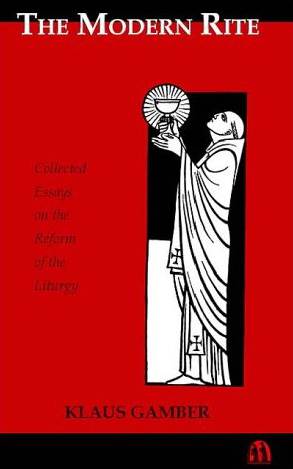 Msgr. Klaus Gamber ga ut en bok med noen artikler om innføringa av den nye liturgien i 1972, men ikke før i 2002 ble denne boka utgitt på engelsk – og først nå rett før jul bestilte jeg den. Det er altså nesten 40 år gamle artikler jeg leser, når jeg nå har kommet halvveis gjennom boka.
Msgr. Klaus Gamber ga ut en bok med noen artikler om innføringa av den nye liturgien i 1972, men ikke før i 2002 ble denne boka utgitt på engelsk – og først nå rett før jul bestilte jeg den. Det er altså nesten 40 år gamle artikler jeg leser, når jeg nå har kommet halvveis gjennom boka.
Den første artikkelen jeg vil nevne, er der msgr. Gamber stiller spørsmålet om messen er et måltid eller et offer; eller rettere sagt hvordan den er begge deler, og på hvilket tidspunkt man kan påvise offeraspektet tydelig hos kirkefedrene. Han avlutter gjennomgangen av kirkefedrene på denne måten:
When Cyprian, in Letter 63:17, after remarking, «In all sacrifices we institute a memorial of his passion,» then adds, «‘for the passion of the Lord is the sacrifice which we offer,» this is likewise a new idea. John Chrysostom says much the same thing; «Our High Priest has offered the purifying sacrifice (cf. Hebrews 10:18). And we now offer the same sacrifice» (Homilies on Hebrews, no. 17:3).
We find the transition to the mediaeval understanding of the sacrifice of the Mass in the writings of Gregory the Great (+ 604), who says, in Dialogue IV, 57-58 (BKV Gregory vol. II. p. 270f.): «This sacrifice saves us in a special way from eternal perdition, since in a mysterious manner it renews for us the death of the Incarnate One. For even though he has risen again and dies no more (Romans 6:9), yet in his immortal and incorruptible life he is offered anew for us in the mystery of the holy sacrifice, his Body is consumed in it, his flesh is shared out for the saving of the people, his blood is poured out … Let us keep in mind, therefore, just what this sacrifice means for us, since for the sake of our redemption it ever anew presents the passion of the incarnate Son. For who amongst the faithful could doubt that in the hour of the sacrifice the heavens are opened at the voice of the priest, that the choirs of angels are present at this mystery, … «
Han sier likevel at offertanket ble for dominerende i middelalderen – men nå har man gått i mostatt grøft:
These foregoing expositions … are intended above all to show one thing, that the idea of the Mass as a sacrifice is as old as the Church, even if it has undergone a certain transformation together with the Church. From the beginning, then, the Mass was both a meal and a sacrifice: a meal at which a sacrifice is offered to God through the Church.
In the Middle Ages, and right up to recent times, too much stress was laid on the idea of sacrifice, and the most diverse theories of the sacrifice of the Mass were constructed, without the appropriate lead having been taken from the Fathers and from the earlier liturgical texts; nowadays people lay stress above all on its aspect as a meal, and they shape their celebration of the Eucharist accordingly. Each of these one-sided attitudes is however wrong. The meal and the sacrifice belong together. …
… Today we have, as in other matters, swung from one extreme to the other: from an overemphasis on the cultic aspect to an overemphasis of the aspect of the Mass as a meal. Already, more and more voices may be heard, calling, against all the tradition, to have the ritual, cultic element removed altogether from our worship.
